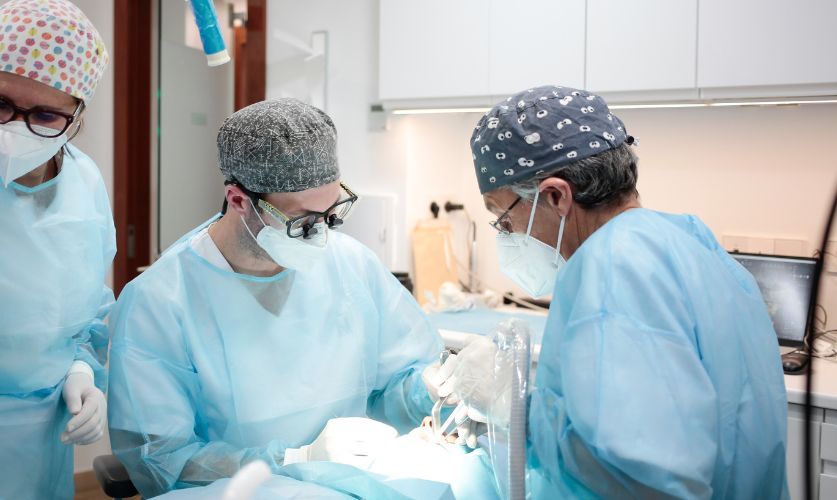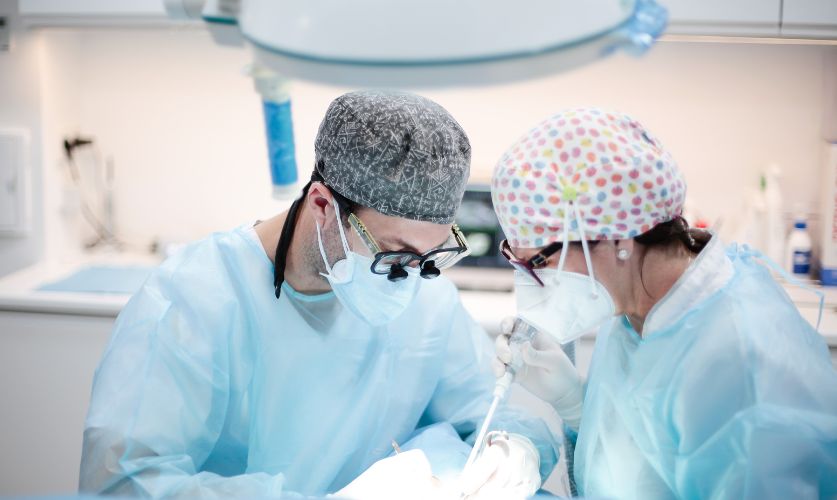BONE GRAFTING FOR DENTAL IMPLANT INSERTION
What is bone grafting for dental implant insertion?
Different scenarios and pathologies can cause bone loss in the maxilla bones. The most frequent cause is natural resorption following the loss of teeth. Infections are another cause, whether due to teeth with cavities or periodontal disease, and old dental implants with problems can result in bone defects that may hinder or impede the placement of dental implants.
A bone graft for dental implant insertion is performed when the patient’s maxillofacial bone structure is insufficient to serve as a support for the dental implants to be used to replace lost teeth. It aims to reconstruct lost bone to allow for the placement of dental implants.
There are a multitude of bone regeneration techniques available but, in general, bone grafting involves using the patient’s own bone (from other parts of the mouth or body) or special biomaterials that are inserted in areas to be regenerated via surgery performed by a dentist specialised in oral surgery and implantology.

Fill in our contact form if you would like to book an appointment at our dental clinic in Valencia:
Types of materials for bone grafting
- Autograft. This uses the patient’s own bone, obtained from a donor area in which there is abundant bone, and transferred to an area with a bone deficiency. It may be obtained in particles or as a block from an area within the region to be grafted or other, further away areas in the mouth, or even other parts of the body. It has a great osteoconductive, osteoinductive, osteogenic and biocompatible capacity. For now, this is the only bone graft with a capacity superior to others in terms of activating regenerative processes and cells. The only downside is that in some scenarios it may be partially reabsorbed over time, for which reason the specialised dentist must have a good understanding of the underlying biology. Although a donor area is required, with suitable planning it is possible in many cases to obtain bone from an area adjacent to the area to be regenerated, therefore limiting the patient’s discomfort.
- Allograft. This graft uses another patient as a donor and the bone used is known as lyophilised bone. Although it has an advantage over the previously mentioned graft (the desired quantity is available and additional surgery to obtain donor bone will not be necessary), this type of graft is infrequently used in dentistry and implantology due to the risks of disease cross-infection between humans. Furthermore, this type of graft is reabsorbed in time.
- Xenograft. This involves graft material from animal species, such as pigs, cows or horses. Its advantage is it may be used in unlimited quantities, without surgery in the donor area. With different treatments, manufacturers obtain a material that is completely safe for human use and which also has different reabsorption patterns and presentations (particles, pastes, blocks, etc.), facilitating its application in all types of scenarios.
- Alloplastic or synthetic graft. The latest materials to be developed are fully created from their basic components in a laboratory. This means using different calcium, phosphate and magnesium salts, among others, it is possible to manufacture regenerating materials in all kinds of formats and with à la carte qualities. These materials are a reality, although for now their function is the same (neither better nor worse) than xenografts. In the future, their characteristics will undoubtedly improve such that they will become the preferred option for bone regeneration.
Bone grafting techniques in implantology
Below, we’ve described some of the bone grafting techniques we regularly use in our dental clinic specialising in dental implants:
- Alveolar ridge preservation. This technique is used following tooth extraction, particularly in the aesthetic area (anterior maxillary), to reduce the natural bone resorption that occurs upon losing a tooth. As less bone is lost, subsequent placement of the implant is simpler and has more predictable aesthetic results.
- Sinus lift. This technique is used on the back area (molars and premolars) of the upper dental arch when bone height up to the maxillary sinus (a cavity we all have in the cranium) is insufficient for implant insertion. Basically, it involves placing the bone graft material between the bone floor of the maxillary sinus and the mucous membrane covering it. Over time, the grafted bone will become the patient’s own bone under this membrane. There are various forms depending on the bone height available: we use an indirect sinus lift with simultaneous implant placement in cases with 5-8 millimetres of bone up to the sinus; direct maxillary sinus lift with simultaneous implant placement in cases with 4-5 millimetres available; and direct sinus lift with deferred implant placement in cases with 3 millimetres or less.
- Guided bone regeneration. This is based on using occlusive membranes to separate the bone from the soft tissues, such that the defects are filled with bone. Without this kind of membrane, bone defects are not filled with bone as the gum grows more quickly. Biomaterials are placed under the membranes to prevent their collapse. The membrane and the biomaterials chosen will depend on the type of defect in question.
- Block bone graft. This involves obtaining blocks of bone from the patient – generally from intraoral areas, such as the mandibular ramus or symphysis menti – and screwing them into the area of the defect we wish to regenerate. In recent times there have been techniques, such as Professor Khoury’s method, which use fine sheets of bone instead of large blocks, that create a barrier (similar to the membranes in guided bone regeneration) to protect particulate bone (autologous or biomaterial) inside. This has the advantage of requiring smaller blocks, causing less damage to the patient and the particulate bone regenerates more quickly and better than large blocks.
- Horizontal bone regeneration. Occasionally, the alveolar bone ridge on which we wish to place dental implants is sufficiently high but insufficiently wide for implant insertion, given that implants need to be completely surrounded by bone in order for them to function correctly and to avoid any problems over time. In some cases, atrophy is moderate and the implant may be inserted while the dehiscence or fenestrations (parts of the implant that remain exposed) are regenerated at the same time using autologous bone or biomaterial. In the event of more severe horizontal atrophy, the bone regeneration specialist dentist has different options: guided bone regeneration, block bone grafts, and ridge augmentation techniques, among others.
- Vertical bone regeneration. In cases of more serious atrophy, whether caused due to infection or a lack of teeth over many years, the bone height is insufficient. Vertical atrophy is a more complicated defect to resolve and it involves a greater challenge for the dentist. In these cases, the patient must definitely consult a specialist with experience in implantology and regeneration. Several techniques exist, all of which are quite recent, for treating this scenario. Some use a guided bone regeneration approach (with membranes that cannot be reabsorbed and which are reinforced with titanium, given that they must be higher and must not collapse) and others use block bone grafts.

Recovery and post-operation
This type of surgery requires a local anaesthetic in all cases, and in more complex cases conscious sedation is also necessary. Therefore, more complex cases cannot be safely treated in many traditional dental clinics as they need facilities and equipment inherent to specialised advanced implantology and complex oral surgery clinics, such as our IDIM Dental Clinic in Valencia.
The recovery process is monitored by the specialist and it is essential that the patient follows his or her indications to guarantee a successful recovery. Our oral implantology specialist will prescribe antibiotics and painkillers to prevent infections and alleviate the pain after the procedure. More significant bone grafts cause substantial inflammatory reactions in some cases; although they are not usually painful they may cause swelling and quite notable bruising, which will disappear within a week or two.
The patient’s oral hygiene is a key factor in preventing infections in the graft, which endanger the aim of the procedure. When a bone graft becomes infected, the chances of gaining bone are minimal. By following our indications and attending check-ups during the weeks and months following a bone graft, the patient is guaranteed to heal well.
The patient must allow sufficient time for recovery, which will enable the dentist to examine the results and determine whether the bone graft has stimulated regeneration of the damaged bone and achieved the procedure’s ultimate goal.
The patient should refrain from consuming hard or hot foods until the area is no longer inflamed. He or she should also avoid efforts such as spitting, brushing the wound area, applying pressure, or vigorously using mouthwashes.
In many bone grafting techniques, the patient cannot use a prosthesis that is supported in the area during this time as the graft’s stability is key to regeneration.
Time periods in achieving bone regeneration
Following this surgical procedure, the patient must wait several months for the body to accept the grafted material and create new, sufficiently strong bone. This waiting time may vary between two and nine months, depending on the type of defect and the regeneration technique used. Patience is key and biology must be respected as, by trying to accelerate the process, there is the risk that what has been achieved will be lost. A team of dentists specialised in advanced implantology and bone regeneration will know how to correctly guide the patient with regard to suitable recovery times.
In cases in which the bone graft required is smaller, it is highly likely the surgeon may perform the bone graft and insert the dental implants in the same surgical procedure. In these cases, the professional must be certain the patient has sufficient bone available in order to fix the implants and then perform the bone graft around them so as to increase the amount of bone supporting the implants.
This decision will depend on the patient’s medical history and a comprehensive assessment of the bone atrophy and bone available, as shown in x-rays (particularly via a cone beam computed tomography or CBCT). The final decision is often not made until the day of surgery.
At our dental clinic in Valencia we specialise in the most complicated cases. We have been working in advanced dental implantology in Valencia for more than 30 years and we are industry leaders.
If your case is complex, book an appointment with us. We would be delighted to assist you.
Other treatments:
· Cavities and endodontics
· Cosmetic dentistry
· Paediatric dentistry
· Orthodontics
· Periodontics
· Dental prosthesis
· Digital dentistry
· Sleep apnoea




